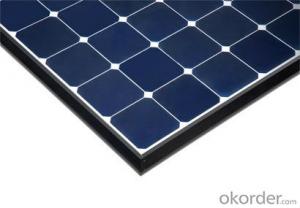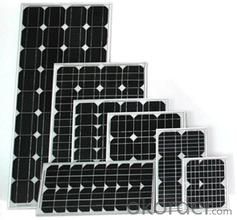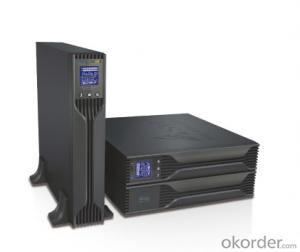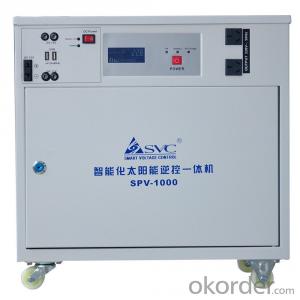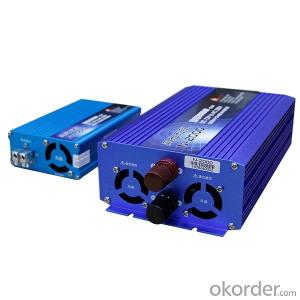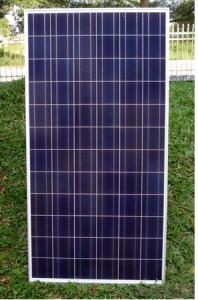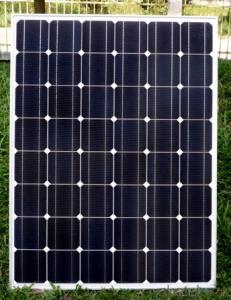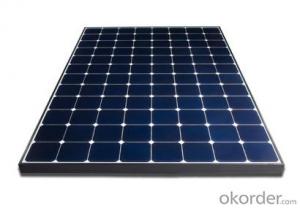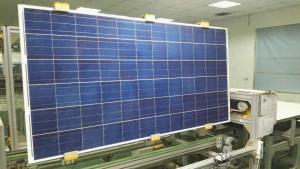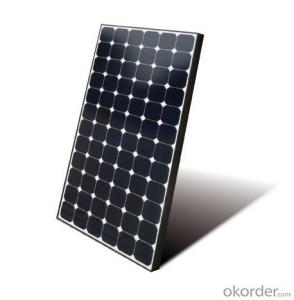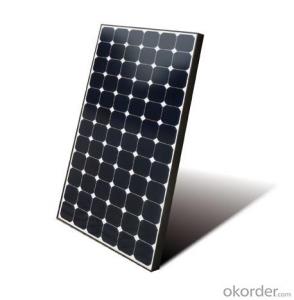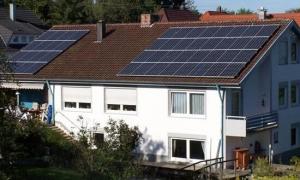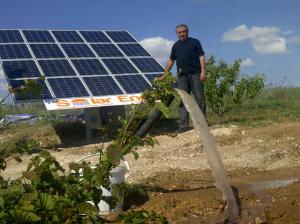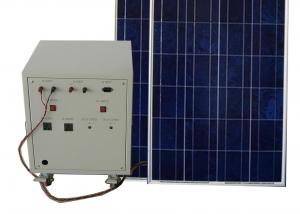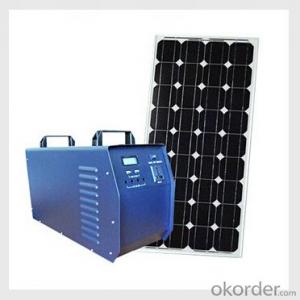Aditya Solar Energy Systems CNBM Poly 100W Off Grid Solar System with 10 Years Warranty
- Loading Port:
- Shanghai
- Payment Terms:
- TT OR LC
- Min Order Qty:
- 100 watt
- Supply Capability:
- 1000 watt/month
OKorder Service Pledge
OKorder Financial Service
You Might Also Like
Specification
CNBM Poly 100W Off Grid Solar Sytem with 10 Years Warranty
Product description
Electrical power can be generated on-site with renewable energy sources such as solar (particularly with photovoltaics), wind, micro hydro, geothermal; with a generator or Micro combined heat and power with adequate fuel reserves. Such a system is called a stand-alone power system. In addition, it is possible to simply eliminate electric power such as in Old Order Amish and Old Order Mennonitecommunities.
A recent concept design by Eric Wichman shows a multi-family community, which combines all of these technologies into one self-sufficient neighborhood. To grow the community you simply add neighborhoods using the same model as the first. A self-sustained community reduces its impact on the environment by controlling its waste and carbon footprint
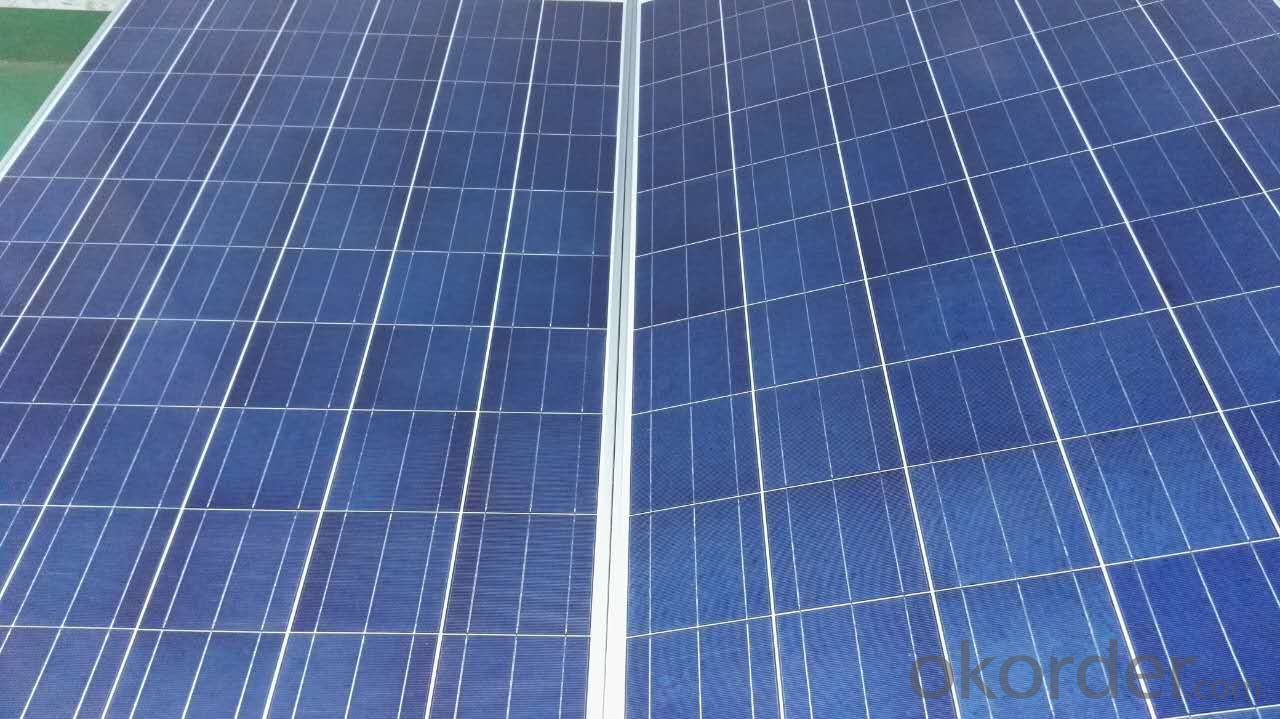
Application
Residential
Commercial
Industrial
Feature
Off-the-grid homes are autonomous; they do not rely on municipal water supply, sewer, natural gas, electrical power grid, or similar utility services. A true off-grid house is able to operate completely independently of all traditional public utility services. The idea has been recently popularized by certain celebrities including Ed Begley, Jr.[3] who stars in the Living with Ed[4] television show on the Home & Garden Television (HGTV) network. Actress Daryl Hannah promotes off-grid living and constructed her home in Colorado according to those principles, as does survival expert and Dual Survival co-star Cody Lundin,[5] who lives in a self-designed, passive solar earth house in the high-desert wilderness of Northern Arizona, collecting rainwater, composting waste, and paying nothing for utilities.[6][7]
Packaging
With carton and box
- Q: Can solar energy systems generate power during cloudy days?
- Yes, solar energy systems can still generate power during cloudy days, although their efficiency may be reduced compared to sunny days. Solar panels can still capture and convert sunlight into electricity even when it's cloudy, albeit at a lower rate. Advances in technology have made solar panels more efficient in low light conditions, allowing them to generate some power even on overcast days. However, the overall output of solar energy systems can significantly vary depending on the density of clouds and the type of solar panels used.
- Q: Can solar energy systems be used in powering restaurants or food chains?
- Solar energy systems are a viable option for providing power to restaurants and food chains. They are an eco-friendly and sustainable source of energy that can effectively reduce operational expenses and minimize the environmental impact of these establishments. Solar panels can be installed on rooftops or in open areas to capture sunlight and convert it into electricity, which can then be utilized for various functions within restaurants, including lighting, refrigeration, cooking equipment, and air conditioning. By adopting solar power, restaurants and food chains not only save on their energy bills but also showcase their dedication to sustainability and environmentally-conscious practices. Moreover, certain governments offer incentives and tax advantages to businesses that opt for solar energy systems, making it an even more appealing choice. All in all, solar energy systems are a practical and eco-friendly solution for powering restaurants and food chains.
- Q: Can solar energy systems be used for emergency response operations?
- Yes, solar energy systems can be used for emergency response operations. Solar power can provide a reliable source of electricity during emergencies, ensuring critical operations such as communication, lighting, medical equipment, and water pumping are sustained. These systems are portable, easy to deploy, and do not rely on an external power grid, making them suitable for remote or disaster-stricken areas. Additionally, solar energy is a clean and renewable resource, reducing reliance on fossil fuels and minimizing environmental impact during emergency operations.
- Q: Can solar energy systems be used in areas with high levels of hail or other severe weather conditions?
- Areas with high levels of hail or severe weather conditions can indeed utilize solar energy systems. Although hail has the potential to damage solar panels, modern designs have been specifically engineered to endure various weather conditions, including hail of a specific size and velocity. Solar panels are typically constructed using durable materials like tempered glass and undergo rigorous testing to withstand hail of a particular size and impact force. They are built to be resilient enough to withstand hailstorms without breaking or compromising their efficiency. Furthermore, panels are often installed at an angle to allow hailstones to slide off rather than directly impact the surface, reducing the risk of damage even further. Moreover, advancements in solar technology have resulted in the production of stronger and more robust solar panels. Some manufacturers even offer panels with enhanced features that make them more resistant to hail, such as reinforced glass or protective coatings. These features provide additional durability, particularly in regions prone to severe weather conditions. It is essential to consider the severity and frequency of hailstorms when planning and installing solar energy systems. Evaluating local weather patterns and historical data can help assess the level of risk and determine appropriate measures to protect the panels, such as using hail guards or installing extra protective layers. To summarize, solar energy systems can be effectively utilized in areas with high levels of hail or severe weather conditions, as long as the panels are designed and installed to withstand such conditions. Careful planning, the use of resilient materials, and regular maintenance can ensure the long-term performance and durability of solar energy systems in these areas.
- Q: How does the efficiency of solar panels degrade over time?
- Solar panels' efficiency declines over time due to a variety of factors. One major cause is the gradual deterioration of the panel's components. Long-term exposure to sunlight, weather conditions, and temperature fluctuations can lead to the degradation of materials such as solar cells, electrical connections, and protective coatings. Another factor that contributes to the decrease in solar panel efficiency is the accumulation of dirt, dust, and debris on the panel's surface. These particles build up and create a barrier between the sunlight and the solar cells, reducing the amount of light that can be converted into electricity. Furthermore, the aging process of the materials used in the construction of solar panels can affect their performance. This can result in a decrease in the panel's ability to effectively absorb sunlight and convert it into electricity. Moreover, potential manufacturing defects or poor installation practices can also impact the efficiency of solar panels. Although these issues may not be immediately apparent, they can lead to a gradual decline in performance over time. It is important to note that the rate at which solar panel efficiency degrades can vary depending on factors such as panel quality, maintenance practices, and environmental conditions. Generally, most solar panels experience a modest degradation rate of approximately 0.5-1% per year. This means that after 25-30 years, the efficiency of the panels may decrease by around 20-30%. To minimize the degradation of solar panel efficiency, regular maintenance and cleaning are recommended. This includes periodically inspecting for any signs of damage, cleaning the surface to remove dirt and debris, and ensuring proper wiring and connections. Additionally, ongoing advancements in solar panel technology and manufacturing processes are continuously being made to enhance their longevity and overall performance.
- Q: What is the role of solar energy systems in promoting social equity?
- The promotion of social equity is one of the crucial roles played by solar energy systems. These systems create equal opportunities for individuals, regardless of their socioeconomic status. Solar energy offers several benefits, with one of the key advantages being its ability to lower energy costs for households and communities. By installing solar panels, individuals can generate their own clean and renewable energy, reducing their dependence on expensive fossil fuels and traditional energy sources. The reduction in energy costs is especially significant for low-income households, who often spend a higher proportion of their income on energy bills. Solar energy systems provide them with an opportunity to decrease their energy expenses, freeing up resources that can be allocated towards other essential needs like education, healthcare, or food. By alleviating the financial burden of energy costs, solar energy promotes social equity by helping to alleviate poverty and enhancing the overall quality of life for disadvantaged communities. Furthermore, solar energy systems contribute to the creation of green jobs and economic opportunities. The installation, maintenance, and operation of solar panels require a skilled workforce, offering employment opportunities for individuals in local communities. This can particularly benefit marginalized populations who may face obstacles to employment due to limited access to education or discrimination. By providing job opportunities in the renewable energy sector, solar energy systems contribute to reducing income inequality and promoting social mobility. Solar energy also has a positive impact on the environment and public health, which is crucial for promoting social equity. Traditional energy sources, like coal or natural gas, contribute to air pollution and climate change, disproportionately affecting low-income communities and communities of color. These communities often reside near power plants or industrial areas, resulting in higher rates of respiratory diseases and other health issues. By transitioning to solar energy systems, these communities can benefit from cleaner air and reduced pollution, leading to improved public health outcomes and a more equitable distribution of environmental benefits. Solar energy promotes social equity by addressing environmental injustices and ensuring that all individuals have equal access to clean and healthy environments. In conclusion, solar energy systems play a vital role in promoting social equity by reducing energy costs, creating job opportunities, improving public health, and addressing environmental injustices. By providing equal access to clean and affordable energy, solar power helps level the playing field and ensures that all individuals, regardless of their socioeconomic status, can enjoy the advantages of renewable energy.
- Q: What is the role of solar trackers in maximizing energy production?
- Solar trackers play a crucial role in maximizing energy production by continuously adjusting the position of solar panels to follow the sun's path throughout the day. This allows the panels to capture the maximum amount of sunlight, increasing the efficiency and output of the solar system.
- Q: Can a solar energy system be used in conjunction with other renewable energy sources?
- Yes, a solar energy system can definitely be used in conjunction with other renewable energy sources. In fact, combining multiple renewable energy sources is often referred to as a hybrid renewable energy system, which can have several advantages. By combining solar energy with other sources such as wind, hydro, or geothermal energy, a hybrid system can provide a more reliable and consistent power supply. This is because different renewable energy sources have different patterns of energy generation, and combining them can help to compensate for any fluctuations or limitations in one particular source. For example, solar energy production is highest during the day, while wind energy can be more consistent throughout the day and night. By integrating these two sources, the system can provide a continuous power supply. Additionally, using multiple renewable energy sources can help to maximize the overall energy production and efficiency of the system. Each source has its own strengths and weaknesses, and combining them can help to increase the total energy output. This is especially valuable in situations where the energy demand is high or when one particular source may not be sufficient to meet the energy needs. Furthermore, a hybrid renewable energy system can also provide greater energy independence and resilience. By diversifying the energy sources, the system becomes less reliant on a single source and therefore less vulnerable to disruptions or failures. This is particularly important in remote or off-grid areas where access to a reliable power supply is crucial. In conclusion, a solar energy system can be effectively used in conjunction with other renewable energy sources to create a hybrid system. This approach offers several advantages, including increased reliability, improved efficiency, and enhanced energy independence. By combining multiple renewable energy sources, we can take advantage of their individual strengths and create a more sustainable and resilient energy system.
- Q: Can a solar energy system be used in areas with limited sunlight?
- Yes, a solar energy system can still be used in areas with limited sunlight. While solar panels do require sunlight to generate electricity, they can still produce power even in areas with less sunlight. Additionally, advancements in solar technology, such as the use of more efficient panels and energy storage systems, have made it possible to harness solar energy in regions with limited sunlight.
- Q: Can a solar energy system be installed on a metal roof?
- Yes, a solar energy system can be installed on a metal roof. In fact, metal roofs are often considered ideal for solar panel installation due to their durability and ease of installation. The metal roof provides a stable and secure surface for mounting the solar panels, and the sleek design of the panels can complement the aesthetics of the roof. Additionally, metal roofs are typically more resistant to weather elements such as hail, wind, and snow, which can further protect and prolong the lifespan of the solar energy system. With proper installation techniques and mounting hardware, a solar energy system can efficiently and effectively generate renewable energy on a metal roof.
Send your message to us
Aditya Solar Energy Systems CNBM Poly 100W Off Grid Solar System with 10 Years Warranty
- Loading Port:
- Shanghai
- Payment Terms:
- TT OR LC
- Min Order Qty:
- 100 watt
- Supply Capability:
- 1000 watt/month
OKorder Service Pledge
OKorder Financial Service
Similar products
Hot products
Hot Searches
Related keywords
